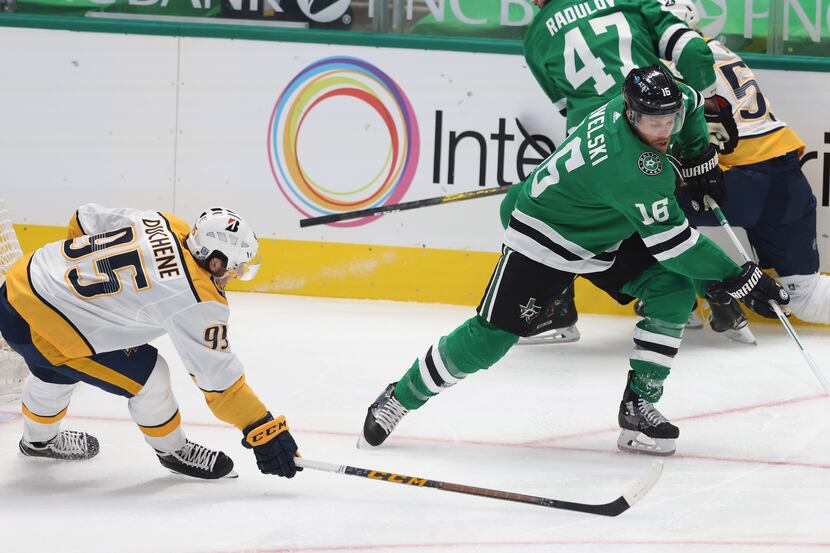The Stars had to wait longer than any other team for their season to start, but they’ve wasted no time in rocketing up the leaguewide leaderboards after sweeping a two-game series with Nashville over the weekend.
Dallas has already jumped to fourth place in the Central Division thanks to 7-0 and 3-2 wins over the Predators. Its power play leads the league by scoring on two-thirds of its chances. The Stars have two players with at least five points already, and Anton Khudobin carries a .961 save percentage.
It’s a picture-perfect start on the ice for the Stars — other than injuries to Jamie Benn and Joel Kiviranta, and Blake Comeau’s inclusion on the COVID-19 protocol list. The opening weekend allowed one main thing to jump out: the potency of the power play.
The Stars have scored eight power play goals through the first two games of the season, a remarkable achievement for a team that was missing Tyler Seguin for both games, and Benn for one. In the first two games, Dallas was twice as likely to score on the power play (eight goals) than it was to come away empty-handed (four times).
There are a number of factors that went into the success, but here are a few.
The power play
1. Player movement within the zone
Power play units often have defined roles for players: This player stands here and shoots, this player parks in front of the net to bury rebounds. The Stars do have a structure that they try to work within, but the first two games have proved that player movement within the offensive zone has been key in getting different looks.
Joe Pavelski is the greatest example. In the first two games on the power play, he has three goals and three primary assists. Pavelski is one of the best puck-tippers and finishers around the net in the NHL, so surely all of his scoring came from that area, right?
Here’s a map of where his production has come from.

That’s one assist from behind the net, one from the point and one from the neutral zone. He’s scored twice on one-timers from the left circle and once on a deflection off his skate in front of the crease.
“I think it always enhances the power play when you have moving parts and you aren’t glued to a spot,” Pavelski said. “We have that understanding that sometimes, you’ve just got to get the puck back. We have a lot of guys that have played different spots and you try to get to your spots when you can and your sets, but there’s going to be times where it’s broken.”
Moving players in the zone helps teams recover loose pucks and retain possession, and Dallas is helped by the fact that Pavelski (net-front, bumper, left circle, point), Alexander Radulov (net-front, right circle) and John Klingberg (point, left circle) are so versatile in their placement in the zone.
Perhaps Roope Hintz and Denis Gurianov will be one day as well, but Gurianov is a one-timer weapon in the right circle, while Hintz roams the left wing to find seam passes.
2. Getting traffic and pucks to the net
This is a simple concept, absolutely, but one that allows bounces to go the Stars’ way.
In two games, the Stars have attempted 39 shots on the power play, which translates to 129.04 shot attempts per 60 minutes on the power play, the most in the NHL. Of course, not all of them got through (13 were blocked) and others missed the net (eight), but challenging the penalty kill makes opponents work more, and distorts their coverage scheme.
Getting pucks to the net allows skill to take over, like Radulov’s between-the-legs tip or Gurianov’s deflection. It gives Pavelski a chance to make a savvy play by presenting his skate for a bank pass. It also gives Kiviranta a chance for a fluky goal that bounced in off him.
Those plays won’t always result in goals, and especially not at the rate the Stars scored over the weekend. But it’s nonetheless a sign of a healthy power play that’s dictating the action.
“Right now, they’re feeling it,” Stars coach Rick Bowness said. “With the skill level that we’re putting out there, when they’re feeling, they’re making great plays, clearly.
“And the puck’s going in, which is certainly beneficial. Right now, you can just feel the confidence that they have. They’re moving for each other.”
Here’s how the eight power play goals broke down by type:
| Category | Goals |
|---|---|
| Tip or deflection | 4 |
| One-timer | 3 |
| Rush | 1 |
-
3. Options entering the offensive zone
The Stars would like to win the faceoff to begin the power play, but they have been just as successful in entering the zone even after losing the faceoff and retrieving a cleared puck. Klingberg is a big reason why, along with Hintz and Gurianov.
When the Stars collect the puck behind their own net, it’s Klingberg and Hintz back there. They play a two-man game of catch before Hintz skates up the left wing for a pass as he enters the zone with speed. It’s a play Hintz and Miro Heiskanen ran often last year, and something that Klingberg now dictates.
But Hintz is not the only option, not by a long shot.
As Hintz is skating up the left side, Gurianov is cutting to the middle at the blue line. If the defender goes to Hintz, Klingberg has Gurianov open in the middle of the ice. Sometimes, it even works out that Gurianov is fast enough to corral a loose puck that slips past him.
“They’re both coming up on their forehands, so I have two options to give it to,” Klingberg said. “I’m just trying to read off what their first forechecker is doing, if he’s trying to cut away to Roope or Denis. Eventually, he’s going to have to make a decision there, and he’s going to be standing a little bit still. I’m going to try to see who’s more open than the other. If that doesn’t work, we have other options too, and drop plays and all that.”
Okay, but what if the other team picks up Hintz way up ice and doesn’t even let him get the puck from Klingberg initially — as Erik Haula does in this clip? Well, Klingberg has Radulov as an option on a long stretch pass.
Sure, but what if they shadow Hintz and Gurianov through the neutral zone, taking away Klingberg’s primary options as he approaches the blue line? Pavelski is waiting at the boards for an easy entrance.
Even when Nashville packed it in and ceded open ice to Klingberg, he took it and carried the puck in himself and allowed the Stars space to set up their attack.
The Stars have armed Klingberg with bullets in Hintz and Gurianov, guaranteed an open man somewhere on the ice, and allowed him to read the play and be the triggerman. Klingberg is one of the best offensive defensemen in the league, and skilled at finding passing lanes, so giving him options on the power play has been a smart move by power play coach Derek Laxdal.
Ty Dellandrea’s first two NHL games
Dellandrea has become a familiar name to Stars fans in the last three years: he was the team’s first-round pick in 2018 at the draft in Dallas, tore up the OHL in his final year there, won gold with Canada at the World Juniors, and is one of the franchise’s top prospects.
He’d played in preseason games, and in the exhibition game in the Edmonton bubble, but made his NHL debut Friday night against Nashville. A natural right-handed, two-way center, Dellandrea shifted to right wing on a line with Andrew Cogliano and Radek Faksa, filling in for Comeau.
“He understands the game, he makes good reads and he skates very, very well,” Bowness said. “He competes very hard. You throw those things together, and you’ve got a pretty disciplined player who’s going to grow and become a very big part of this team moving forward.”
Bowness showed both Friday and Sunday that he trusts Dellandrea an awful lot for a 20-year-old rookie playing in his first NHL regular-season games. Dellandrea was on the penalty kill both games, on the second power play unit Sunday night, took key right-handed faceoffs late in the game, and was on the ice for the final minutes when Nashville pulled its goalie.
On Sunday, in a one-goal game, Dellandrea logged 16:16 of ice time, including four shifts in the final eight minutes. His usage demonstrates that the Stars coaches trust him to be responsible defensively and help close out a win. (For comparison, offensive-minded rookie winger Jason Robertson was on the bench for the last 10:54 of Sunday’s game.)
How did Dellandrea earn trust so quickly?
It started even before his debut this season, as Bowness pointed out that Dellandrea played this role on Team Canada at the WJC in 2019. It carried into training camp, when players credited Dellandrea with ratcheting up the intensity.
And it continues with reading off his teammates to make responsible decisions. In these next clips, Dellandrea notices defensemen Jamie Oleksiak and Miro Heiskanen activating on defense and replaces them at the point.
It’s something that happens tens of times during NHL games, but it still remains important for the style of game the Stars want to play, and it is a small thing that coaches notice when they think about who to trust defensively on the ice. Coaches often talk about players not cheating for offense, and this is an example that allows the Stars to maintain possession and protect against odd-man rushes the other way.
“It’s definitely more thinking, more to prepare and that’s fun,” Dellandrea said. “I’ve noticed being here how there’s a lot of thinking, a lot of tight detail and it’s fun that way. You’re trying to figure out a game and win mentally, physically. There’s a lot more read and react and adjusting, and I like that.”
There are a few other instances of Dellandrea doing this over the weekend, but those clips would be redundant.
Dellandrea has become a regular part of the Stars penalty kill with Seguin and Comeau out (both right-handed forwards who can take faceoffs). When Pavleski needs a breather, Bowness doesn’t hesitate to put Dellandrea at the dot in his own zone.
Blocking shots like this on the penalty kill also draws coaches’ attention.
Dellandrea has also been able to sneak out of his own zone to generate scoring chances on the rush, both at even strength and shorthanded. Not many of the chances were Grade-A ones, but it still shows an ability and awareness to read the play correctly and time his zone exit well.
“The thing with Ty is I think he’s a really conscientious kid,” Cogliano said. “I think he’s a guy that’s accepting of information, and you can tell he has really strong character. When you have a player and a person like that, he’s just going to want to get better. He’s going to learn things very quickly.”
It hasn’t been perfect for Dellandrea in two games, though. At times, the 6-1, 190-pound rookie has been pushed around in front of the net and along the boards. Bowness and the Stars also realize that sometimes, even with the right decision, Dellandrea will get beat simply because of the size, skill and speed of NHL players.
But for a 20-year-old making his NHL debut, it’s been quite the start to the season.
+++

